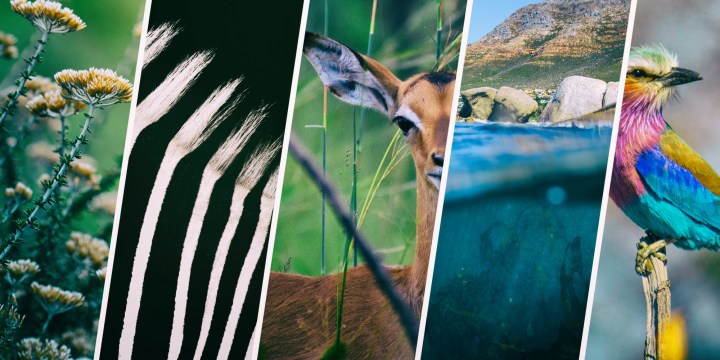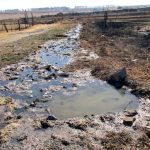PROTECTED AREAS
With nature and biodiversity under threat everywhere, bold conservation funding ideas are needed

How can South Africa double the land it has under conservation by 2030 when many of its wildlife reserves are falling apart? With a limited conservation budget from the fiscus, tax incentives could play a big role.
If South Africa were to meet the conservation targets committed to at the last UN Biodiversity Conference, we’d need to protect the equivalent of the Kruger National Park, and then some, every year from now until 2030.
But how is this achievable when our private and state reserves are falling apart and increasingly threatened by declining budgets, understaffing and poaching?
“We have recognised that in advancing this vision of 30 by 30… we must ensure that the existing conservation networks [are] also taken care of because that is where our biodiversity is anchored,” said Mohlago Flora Mokgohloa, deputy director-general (DDG) in the Department of Forestry, Fisheries and the Environment (DFFE) during a workshop earlier this month to find ways to implement the headline “30×30” protected areas target from the last UN Biodiversity Conference (COP15) agreement.
Read more in Daily Maverick: SA needs to preserve the equivalent of Kruger Park each year to meet UN goals
The 30×30 target aims to effectively conserve at least 30% of the world’s lands, freshwater and oceans by 2030, while also respecting the rights and contributions of indigenous peoples and local communities.
Currently, 16.7% – or just more than 20 million hectares – of the total 121 million hectares of land in South Africa is under conservation.
However, Karl Naudé, the director of protected area planning at the DFFE, explained to Daily Maverick that only 9.8% of that is considered a “protected area”; in other words, formally declared under the National Environmental Management: Protected Areas Act. This includes national parks, world heritage sites and nature reserves.
If we were to reach the 30×30 target by the deadline, South Africa would have to add an additional 16 million hectares to the conservation estate, which is the equivalent of adding the Kruger National Park and a bit extra every year from now until 2030, Naudé said.
Provincial ‘paper parks’
Daily Maverick previously reported that a conservation assessment by the Endangered Wildlife Trust (EWT) cautioned that our existing conservation estates cannot be allowed to become “paper parks” – meaning that they exist as areas of conservation on paper only and are not being protected in reality.
On paper, there are more than 400 provincial parks and reserves spanning more than three million hectares of the 20 million protected in SA. But most of these provincial parks are failing due to management issues, insufficient budget or lack of political will.
Read more in Daily Maverick: More money, better leadership, trained staff: How to prevent SA’s provincial wildlife gems from sliding into ruin
Mokgohloa, who is the DDG for the department’s biodiversity and conservation branch, explained that all South Africa’s parks fall into four categories: national parks, provincial, parks, municipal parks and privately owned parks – and while the national parks are doing relatively well, the same can’t be said for provincial parks.
Mokgohloa said that “provincial budgets have declined over the years”, with national government departments and their entities spending R36.1-billion, or 60%, on biodiversity from 2009 to 2015, compared with provincial government departments and entities (R19.7-billion, or 33%) and local government (R4.1 billion, or 7%), according to the 2016 Biodiversity Expenditure Review compiled by the United Nations Development Programme’s Biodiversity Finance Initiative (Biofin).
“We can’t continue to expand if we are not addressing the management effectiveness of the existing parks, which is what the management authorities are working on,” acknowledged Mokgohloa.
For example, the EWT report found that the Ntsikeni Vlei Nature Reserve in KwaZulu-Natal only has a single field ranger to patrol the 9,200ha of land, with more than 1,000 livestock roaming around.
Mokgohloa said that they were looking at improving the physical infrastructure (fencing) of Hluhluwe-Imfolozi Park in KZN, which is a hotspot for rhino poaching.
“We are then looking into what are the policy and legislative enablers we can bring in so that we can improve the state of the existing nature reserves,” said Mokgohloa.
Lack of funds
According to the latest – 2016 – Biodiversity Expenditure Review by Biofin, about 0.93% of consolidated government expenditure was directed towards biodiversity conservation-related activities a year between 2009 and 2015.
Mokgohloa emphasised that as less than 1% of the fiscus went toward conservation (public expenditure is the largest contributor to conservation), SA would need a lot more money to reach the 30% target by 2030.
The DFFE is also the single biggest key finance actor for biodiversity in the country, with the department accounting for an average of 33% of total public sector biodiversity expenditure from 2009-2015.
More recently, the DFFE reported that in the 2023/24 financial year, SANParks – which is mandated to oversee the conservation of South Africa’s biodiversity, landscapes and associated heritage assets through a system of national parks – has an annual budget of R3.867-billion (the budget was R3-billion in the 2022/23 financial year).
But according to Candice Stevens, the chair of Africa’s Sustainable Finance Coalition, the extra finance needed can’t just come from the private sector either.
Stevens explained to Daily Maverick that if we are going to reach the ambitious targets we agreed to at COP15, “we are going to require a considerably large amount of sustainable finance… finance beyond the traditional donor and grant funding sectors to bring in the private sector as well as align incentives.”
The DDG agreed that the government will never find enough money to buy private land for new reserves, and thus would need to find ways to further incentivise landowners to protect their land and the species that inhabit them.
So we need other means.
Tax incentives
Stevens, who is also co-chair of the IUCN WCPA Sustainable Finance Specialist Group, said that South Africa has actually made considerable progress in establishing positive tax incentives that act as a reward for conservation commitment.
The first tax incentive put in place along with National Treasury was Section 37D of the Income Tax Act, which entitles a taxpayer who declares a protected area (from an individual to a private company or community association) to deduct the full value of the land from their taxable income.
“This is extraordinary because nowhere else in tax legislation, regardless of who you are, or what you do that attracts tax, can you deduct the value of land. So only if you make the highest-level conservation commitment can you deduct the full value of land from taxable income,” said Stevens.
Stevens explained that what sets SA apart is that, “South Africa has very strong legislation in terms of protected areas that require long-term management, and are designated in the highest biodiversity value areas of the country.
“And because of this legislation, we were able to then create a tax incentive and implement it with National Treasury, because the tax incentive attaches to the highest conservation commitment that a private or communally owned piece of land can undertake.”
Stevens explained that the Sustainable Finance Coalition incubated this tax incentive as a finance solution with partners including Birdlife South Africa, Wilderness Foundation Africa and the South African National Biodiversity Institute (Sanbi), along with the DFFE and National Treasury.
It was piloted in 2016 and launched as a new tax incentive into tax returns at the end of 2016. And now it’s a finance solution that’s gone to scale, with Stevens saying that, as of 2020, the estimated value of the tax incentive is about R1.4-billion of finance dedicated toward long-term conservation.
For launching this successful incentive, the SA government and Stevens received the UN Pathfinder Award Special Commendation. The innovation is now being used by other countries such as Spain, Kenya, Chile and Peru to begin looking at incentives in those countries for their private and communal land conservation.
“If we can continue to demonstrate that those areas are contributing to our conservation objective and able to make a case to the National Treasury and Sars, we might be able to expand the tax incentive to other areas,” said Mokgohloa.
Out of bounds
Another tax incentive the Sustainable Finance Coalition incubated is one that attaches itself to “Other Effective area-based Conservation Measures” (OECMs) – areas that achieve long-term conservation outside of protected areas – and are deliberately attributable to the management costs of threatened species.
Stevens explained that this tax incentive benefits South African citizens who are safeguarding these species that don’t necessarily live within protected areas and are incurring management costs as a result.
“It’s very expensive to look after a rhino or a lion. And a lot of the anti-poaching costs are the reason for how expensive the species are to safeguard,” said Stevens.
“So this tax incentive comes in to be able to allow those management costs to be deducted in an extraordinary way, and to alleviate the cost burden. And essentially, reward a conservation commitment for threatened species.”
The incentive is now sitting with the DFFE, who are poised to take it to scale.
Biodiversity stewardship
Another benefit that is felt by individual South African citizens who safeguard land is an approach called biodiversity stewardship.
Mahlodi Tau from Sanbi explained to Daily Maverick that biodiversity stewardship is an approach that the government uses in the conservation sector to secure land in biodiversity priority areas through entering into contractual agreements with private landowners, occupiers of communal land and communal property associations.
“The owners of the land enter into voluntary agreements with the government to secure their land under biodiversity stewardship,” explained Tau.
For instance, a private landowner can have their own land declared a nature reserve. So instead of the colonial approaches of the past, biodiversity stewardship does not displace land owners from their land, but rather it encourages landowners to declare that land either as a nature reserve, or they enter into other contractual biodiversity agreements.
“By doing that, we encourage landowners to manage their land sustainably with the support from conservation authorities, like CapeNature or Ezemvelo KZN Wildlife.
“Biodiversity stewardship is going to be one of our principal tools to achieving our 30 by 30 goals,” said Stevens.
“And we can then utilise tax incentives like 37D to be able to support private and communal South African taxpayers to undertake and support these commitments alongside the government.” DM
To read all about Daily Maverick’s recent The Gathering: Earth Edition, click here.



















 Become an Insider
Become an Insider
Tax incentives are all very fine, but they reduce the amount of tax that the government receives. So what is the likelihood of the Government allowing them? The ANC likes to control as much as possible, so would not like private individuals making discretionary payments and then claiming them off tax. The ANC government would rather direct the payments themselves.
As far as rhinos are concerned, there is only one solution: Allow the sale of the rhino horn. Farmers would soon produce enough horn to satisfy the demand, making poaching less attractive.